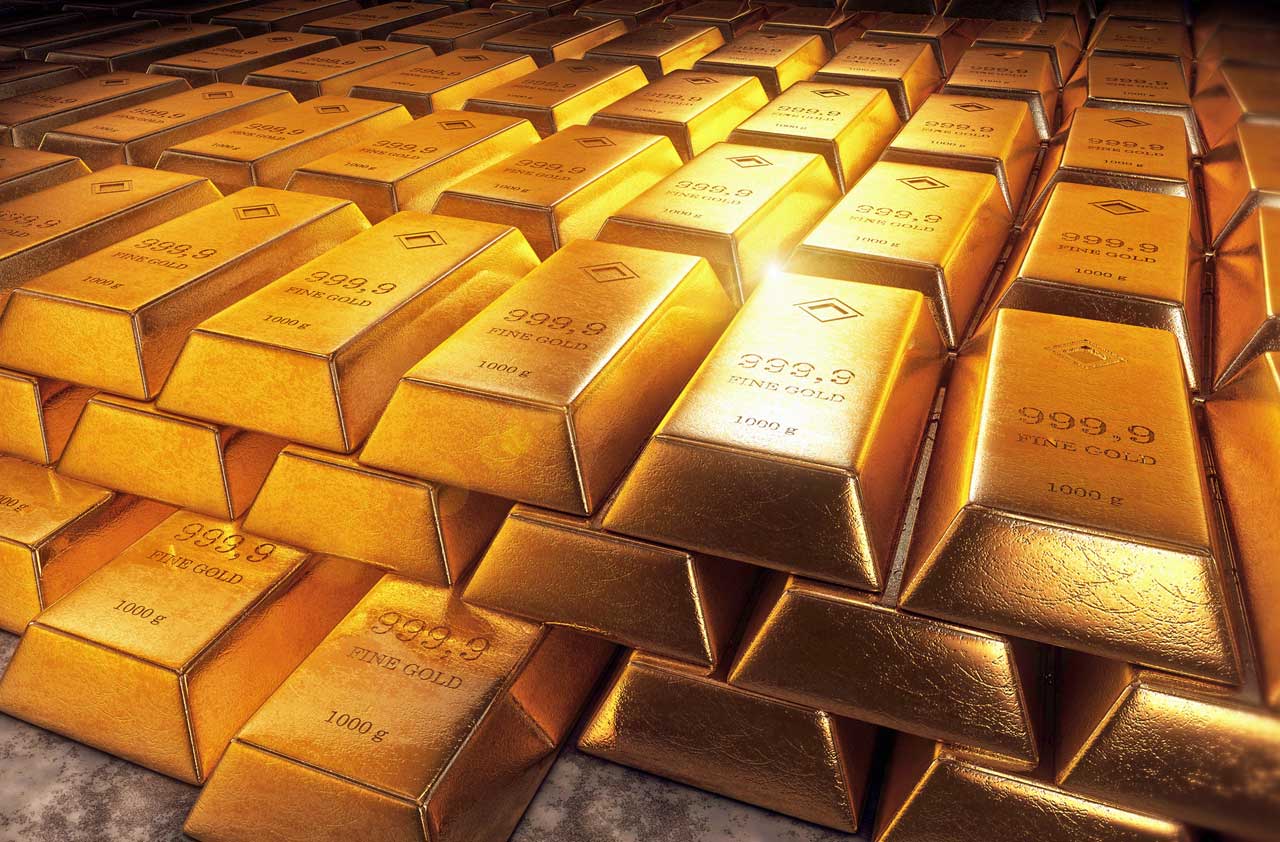An Investor's Guide to the Gold Rally
And two ways to play a rally. Just don’t bet the milk money.

After a long downward spiral, gold is showing some luster again. An ounce of the metal now fetches $1,231, up 16% since December. Gold-mining stocks have done better—much better. Year-to-date, VanEck Vectors Gold Miners ETF (symbol GDX, $23.03), an exchange-traded fund that tracks an index of mining stocks, has soared 68%. The rally makes gold one of the best-performing asset classes of 2016, handily beating stocks and bonds. So should you jump aboard the gold train? Although the price could keep climbing, buyers should beware. Here are five things you need to know if you’re thinking of investing.
What’s driving the rally in the gold price?
Although gold is technically a commodity, it’s really in a class by itself. Unlike other commodities, the price doesn’t just hinge on industrial demand (which, in gold’s case, is mainly for jewelry). Investors also view gold as a currency, one that has endured since the ancient Egyptian pharaohs. Prices rise when investors grow nervous about the stock market, geopolitical instability and inflation. Concerns about inflation can send gold prices climbing if investors decide that paper currencies, backed by nothing of tangible value, will lose purchasing power.
Lately, gold appears to have spiked for two main reasons. The first is that the metal is priced in dollars, and when the dollar weakens it becomes more expensive for foreign buyers to purchase an ounce of the commodity. Although the inverse relationship between gold and the dollar can break down for long stretches, it has been relatively tight lately, with the dollar weakening between late November and early May and the price of gold jumping.
From just $107.88 $24.99 for Kiplinger Personal Finance
Become a smarter, better informed investor. Subscribe from just $107.88 $24.99, plus get up to 4 Special Issues

Sign up for Kiplinger’s Free Newsletters
Profit and prosper with the best of expert advice on investing, taxes, retirement, personal finance and more - straight to your e-mail.
Profit and prosper with the best of expert advice - straight to your e-mail.
Gold is also rallying, some analysts say, because interest rates remain near rock bottom in major developed economies, and they may not climb as much as investors had expected. Government bond rates are now so low in Europe and Japan that they’re actually negative; investors are paying governments for the privilege of lending them money. Moreover, some bonds pay less interest than prevailing inflation rates, meaning that investors are practically guaranteed a loss, after inflation, if they hold the bonds to maturity. Gold bullion doesn’t pay anything, of course, and incurs storage and other costs. But at least it can hold more of its value than these government bonds, the argument goes, making gold a better bet.
Investor demand for gold, in fact, appears to be the main driver pushing up prices. Investors bought $8.4 billion more in gold and mining ETFs than they sold in the first three months of the year, according to research firm FactSet. Overall, global demand for gold climbed 21% in the first quarter, according to the World Gold Council, which sponsors the SPDR Gold Shares (GLD), an exchange-traded product that tracks the price of bullion. Investors who buy exchange-traded products, along with central banks, accounted for much of that increase in demand, says the council.
Does the gold rally have legs?
The metal could keep climbing if the dollar slides further or investors start to worry that inflation will spike. But neither scenario looks highly likely right now.
The Federal Reserve has signaled that it may increase its benchmark short-term rate this June, which is sooner than expected. Higher U.S. rates would likely push up the dollar, depressing the price of gold. Indeed, the dollar has edged up (and gold has slumped) since word broke on May 18 that Federal Reserve members have warmed up to the idea of hiking short-term rates at their June meeting.
Some analysts also think the rally will peter out because gold is in the grips of a 20-year “bear super cycle.” That’s the view of John LaForge, head of real asset strategy at Wells Fargo Investment Institute. As he sees it, commodities move in tandem in long upward or downward cycles. “Investors either really love commodities or they really hate them,” he says. For decades, the average bull market in commodities has lasted for 16 years, while the average bear market (a decline of at least 20% from peak prices) has endured for 20 years.
If the pattern persists for gold, it could be many years before the metal reaches new highs. LaForge believes the bear market in gold kicked off in September 2011, when prices peaked at $1,895 an ounce. If gold is in a long bear market, this rally would just be a bounce off the lows, with gold headed back down as mining capacity ramps up, boosting supplies. “At $1,250 an ounce, miners that had shut down mines when the price was $1,000 can get back in and start making money again,” he says.
[page break]
Will gold protect you against a stock market downturn?
Worrywarts love gold because they believe it’s one of the few investments that can act as a “safe haven” when things look bleak. Some advisers recommend holding 2% to 5% of a diversified stock-and-bond portfolio in gold as a hedge against a stock market downturn or some unforeseen economic crisis.
Yet the idea that gold will protect your portfolio from a downturn in stocks isn’t a slam dunk. True, gold and stock prices can diverge—most notably in August 2011, when gold peaked and U.S. stocks hit a low after Standard & Poor’s downgraded the U.S. government’s credit rating. Although gold tumbled for months during the financial crisis, the metal wound up posting a 3% gain in 2008, when Standard & Poor’s 500-stock index plummeted 37%.
Yet since 1975, when gold first started trading freely, bullion prices have moved in and out of lockstep with the stock market, converging and diverging a similar number of times. “It’s a coin flip,” says Claude Erb, an independent researcher in Los Angeles who wrote an academic paper about gold with Campbell Harvey, a professor at Duke University’s Fuqua School of Business.
Granted, gold can help to diversify a portfolio. But don’t mistake the metal for a true safe-haven asset like cash. If the stock market tumbles 20%, gold may not fall as much, but it could still decline. Moreover, anemic periods for stocks can be deadly for gold. In 2015, a year in which the S&P 500 eked out a 1.4% return, the price of gold fell 11% and the VanEck gold-mining-stock ETF plunged 25%. “It would be very misleading to conclude that if there’s a crisis in the stock market, then gold will somehow provide positive returns to make up for that,” says Harvey. If you want a safe haven, he advises, stick with cash.
Will gold be a good hedge against inflation?
Gold bugs argue that the metal provides the best way to protect your purchasing power in a world of devalued currencies and steeper inflation. But the historical evidence isn’t so convincing.
Although gold started ascending in the early 2000s, it spent decades in decline before then. From 1980 to 2000, the “real” price of gold (that is, adjusted for inflation) fell by about 70%. In other words, an ounce of gold in 1980 held just 30% of its value 20 years later. U.S. inflation edged lower in that span, but it was never zero. In Brazil, which experienced 250% annualized inflation from 1980 to 2000, holding gold was no panacea.
These days, central bankers seem more concerned about deflation than inflation. And gold may not be a good bet because it looks overvalued. Adjusted for inflation, the price should be $820 an ounce, says Erb, 34% below current levels. Gold may be a winning wager at those prices, but not today.
If you want to invest in gold, what’s the best way to go?
Gold advocates typically opt for bullion or coins, arguing that it’s the only way to really safeguard the investment. Buy bars or coins, though, and you’ll need to store it in a vault or pay a firm to hold it for you.
Gold ETFs make it easier to invest. The ETFs closely track the day-to-day price of the metal, and they store gold in amounts equivalent to the size of their fund assets. The largest such fund, SPDR Gold Trust (GLD, $116.98), has $34.1 billion in assets, making it one of the largest exchange-traded products on the market. Its annual expense ratio is 0.40%. (Unless otherwise indicated, all prices and returns are through May 25.)
A cheaper ETF is iShares Gold Trust (IAU, $11.81). Its annual expense ratio of 0.25% makes it more cost-effective than the SPDR fund. So far this year, the ETF has gained 15%, and it has returned an annualized 6.2% over the past decade, according to Morningstar.
Mining stocks offer more bang for the bar, both on the up side and on the down side. The VanEck Vectors Gold Miners ETF (GDX) holds a basket of the big miners, with its top three holdings—Barrick Gold (ABX), Newmont Mining (NEM) and Goldcorp (G)—accounting for about one-fourth of the fund’s assets. The fund, which charges 0.52% annually, has slumped sharply as the price of gold has retreated recently. From the May 17 close through May 24, the ETF sunk 12%. Even with this year’s rally, the ETF has lost some two-thirds of its value since peaking in September 2011.
WEALTH CREATION: How to Protect Your Portfolio Against Black Swans
Profit and prosper with the best of Kiplinger's advice on investing, taxes, retirement, personal finance and much more. Delivered daily. Enter your email in the box and click Sign Me Up.

-
 Stocks Chop as the Unemployment Rate Jumps: Stock Market Today
Stocks Chop as the Unemployment Rate Jumps: Stock Market TodayNovember job growth was stronger than expected, but sharp losses in October and a rising unemployment rate are worrying market participants.
-
 Should You Renew Your CD?
Should You Renew Your CD?With rate cuts impacting earnings, we examine if now is a wise time to renew CDs.
-
 7 Ways to Plan Now to Save on Medicare IRMAA Surcharges Later
7 Ways to Plan Now to Save on Medicare IRMAA Surcharges LaterUnderstand the critical two-year lookback period and why aggressive planning before you enroll in Medicare is the most effective way to minimize IRMAA.
-
 If You'd Put $1,000 Into Coca-Cola Stock 20 Years Ago, Here's What You'd Have Today
If You'd Put $1,000 Into Coca-Cola Stock 20 Years Ago, Here's What You'd Have TodayEven with its reliable dividend growth and generous stock buybacks, Coca-Cola has underperformed the broad market in the long term.
-
 If You Put $1,000 into Qualcomm Stock 20 Years Ago, Here's What You Would Have Today
If You Put $1,000 into Qualcomm Stock 20 Years Ago, Here's What You Would Have TodayQualcomm stock has been a big disappointment for truly long-term investors.
-
 If You'd Put $1,000 Into Home Depot Stock 20 Years Ago, Here's What You'd Have Today
If You'd Put $1,000 Into Home Depot Stock 20 Years Ago, Here's What You'd Have TodayHome Depot stock has been a buy-and-hold banger for truly long-term investors.
-
 If You'd Put $1,000 Into Bank of America Stock 20 Years Ago, Here's What You'd Have Today
If You'd Put $1,000 Into Bank of America Stock 20 Years Ago, Here's What You'd Have TodayBank of America stock has been a massive buy-and-hold bust.
-

 If You'd Put $1,000 Into Oracle Stock 20 Years Ago, Here's What You'd Have Today
If You'd Put $1,000 Into Oracle Stock 20 Years Ago, Here's What You'd Have TodayORCL Oracle stock has been an outstanding buy-and-hold bet for decades.
-
 If You'd Put $1,000 Into Sherwin-Williams Stock 20 Years Ago, Here's What You'd Have Today
If You'd Put $1,000 Into Sherwin-Williams Stock 20 Years Ago, Here's What You'd Have TodaySherwin-Williams stock has clobbered the broader market by a wide margin for a long time.
-
 If You'd Put $1,000 Into UnitedHealth Group Stock 20 Years Ago, Here's What You'd Have Today
If You'd Put $1,000 Into UnitedHealth Group Stock 20 Years Ago, Here's What You'd Have TodayUNH stock was a massive market beater for ages — until it wasn't.
-
 If You'd Put $1,000 Into Berkshire Hathaway Stock 20 Years Ago, Here's What You'd Have Today
If You'd Put $1,000 Into Berkshire Hathaway Stock 20 Years Ago, Here's What You'd Have TodayBerkshire Hathaway is a long-time market beater, but the easy money in BRK.B has already been made.

